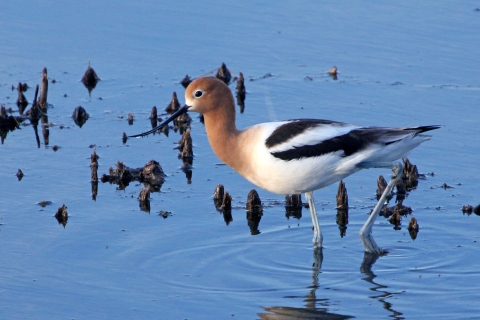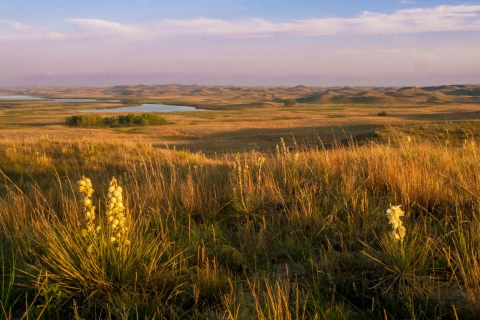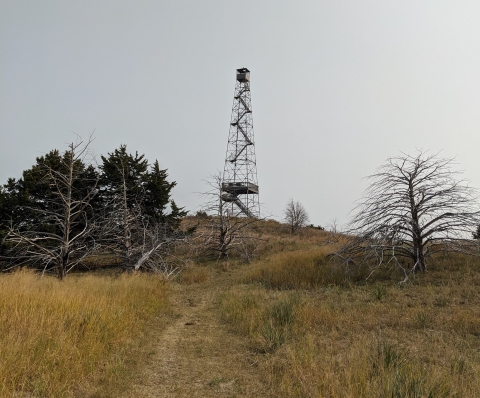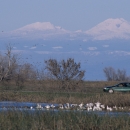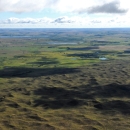Visit Us
Valentine National Wildlife Refuge is an excellent spot to enjoy the great outdoors! Take your pick from bird watching, fishing, hiking, road touring, hunting, wildlife viewing and photography. We have something for everyone!
Valentine National Wildlife Refuge will be having a temporary road closure near the east side of 21 Lake.
Activities
Whether it is bird watching, fishing, hiking, touring, or hunting, Valentine National Wildlife Refuge is the perfect spot to enjoy the great outdoors! Check out our list of activities and choose your own adventure.
Please stop by the office or give us a call at 402-376-1889 for seasonal information.
Trails
There are two walking trails on the Refuge that offer bird watching and wildlife viewing opportunities; The Civilian Conservation Corps Fire Tower Trail and the Marsh Lake Overlook. Pick up a brochure at the Refuge Visitor Center for a map of the area.
Other Facilities in the Complex
Fort Niobrara National Wildlife Refuges supports an exceptional diversity of plants and wildlife representative of the northern Great Plains and geographic regions east, west, north, and south of here. In the early 1900s, President Theodore Roosevelt and private conservation organizations, such as the National Audubon Society and American Bison Society, were becoming increasingly concerned with the exploitation of wildlife and their habitats on the Great Plains and elsewhere. As a result, an Executive Order was signed on January 11, 1912, establishing Fort Niobrara as a "preserve and breeding ground for native birds." Later that year, the Refuge's purpose was expanded to include the conservation of bison and elk herds representative of those that once roamed the Great Plains.
Lacreek National Wildlife Refuges lies in the shallow Lake Creek valley on the northern edge of the Nebraska Sandhills and includes 16,410 acres of native sandhills, sub-irrigated meadows, impounded fresh water marshes, and tall and mixed grass prairie uplands. The Refuge serves as an important staging area for migrating waterfowl, sandhill cranes, shorebirds, and neotropical migrants. Providing critical wintering habitat for the high plains trumpeter swan population is a primary goal.
Crescent Lake National Wildlife Refuges lies on the southwestern edge of the Nebraska Sandhills, the largest sand dune in the Western Hemisphere. The Sandhills are characterized by rolling, vegetated hills and interdunal valleys. These habitats on the Refuge are interspersed with 21 wetland complexes—shallow lakes, marshes, seasonal wetlands, wet meadows, and a small stream. Wildlife diversity, except large ungulates and their predators, is relatively unchanged since early settlement.
North Platte National Wildlife Refuges was established in 1916 by Executive Order No. 2446 as a “preserve and breeding ground for native birds.” It is located in the Nebraska Panhandle, near Scottsbluff. It was declared a National Wildlife Refuge primarily because of fall concentrations of up to 250,000 Mallards, 11,000 Canada Geese and Bald Eagles.
John W. and Louise Seier National Wildlife Refuges is found in north-central Nebraska, as a sanctuary among the Sandhills. The Sandhills region is the largest remaining tract of mid and tall grass prairie in North America. The Seier Ranch was originally homesteaded by John and Louise Seier’s grandparents in the mid-1800's. John and Louise Seier did not have any immediate family, but did have a love of wildlife and an interest in preserving wildlife, they donated, their 2,400 acre working cattle ranch to U.S. Fish and Wildlife Service in October of 1999. Because the Refuge is so new to the System, it remains closed to the public at this time. There is no projected date for the opening of the Refuge, however, a date will be established upon the completion of a management plan.
Rules and Policies
Your visit, and that of others, can be made more enjoyable by following a few simple rules. If you have questions on rules or regulations stop by the office or give us a call at 402-376-1889.
To protect wildlife and habitats the following regulations are enforced.
- The Refuge is open to the public during daylight hours only.
- Vehicles must stay on designated roads. Off road driving is prohibited. All-terrain vehicles are not allowed on or off road.
- Camping and fires are prohibited. State and private campgrounds are located nearby.
- Collecting plants, animals, or historic artifacts is not allowed.
- Check the refuge fishing and hunting brochure for special regulations for these activities.
Locations
We welcome you to visit Valentine National Wildlife Refuge! Please call, e-mail, or write and we will be happy to help you plan a trip and answer any questions you may have. If no answer, please leave a message on extension 100 and we will get back to you.
Valentine National Wildlife Refuge – Office hours are 8 AM to 4:30 PM, Monday through Friday, excluding federal holidays
Headquarters Address: 39679 Pony Lake Road, Valentine, NE 69201
402-376-1889
Manager: Juancarlos_Giese@fws.gov
We are located 27 miles south of Valentine, NE off of Highway 83; and 41 miles north of Thedford, NE on Highway 83.
Navigating by GPS? Enter coordinates:
N 42* 29’ 12.224”
W 100* 31’ 12.28”
Click here for Google map directions to the Refuge from Valentine, NE.


